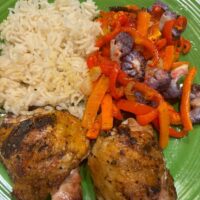Gobble Up These Thanksgiving Preparation Tips
Thanksgiving is a time for gratitude, gathering, and indulging in an amazing feast.
However, hosting can sometimes feel more like a marathon than a celebration. Between juggling the turkey, sides, and desserts, it’s easy to feel overwhelmed.
The key to a stress-free holiday?
Smart planning and a few creative tricks to streamline the process. From prepping dishes days in advance to setting the table early and organizing a foolproof cooking timeline, there are plenty of ways to make the big day easier.
With these Thanksgiving preparation tips, you’ll spend less time in the kitchen and more time enjoying the moments that matter. 
Create a Master Thanksgiving/Holiday Grocery List
I have a master list (Word document) for my holiday grocery shopping that I update as necessary. It saves time because I typically make the same recipes for Thanksgiving and Christmas. If I decide to make something new, it’s quicker and easier to update the list rather than creating it from scratch. Organize your grocery list by sections of the store to streamline your trip. Double-check pantry staples like flour, sugar, and spices to avoid unnecessary trips to the store and last-minute panic.
Create a Detailed Timeline
Start by listing all the dishes you’ll serve and work backward from dinnertime. Assign tasks to specific days, such as grocery shopping the weekend before, prepping veggies two days out, and baking desserts the day before.
Make and Freeze
Many dishes, like cookies, bread rolls, and casseroles, freeze beautifully. Prepare these a week or so in advance and freeze them. On Thanksgiving morning, you’ll just need to reheat.
Pre-Chop Ingredients
Dice onions, celery, and other veggies ahead of time and store them in labeled containers in the fridge. This will save you from the last-minute scramble when making stuffing, soups, or casseroles.
Prep Serving Dishes
Assign each dish to a serving bowl or platter ahead of time, and label them with sticky notes. This makes plating quicker and ensures you have everything you need. This also gives you time to clean any dishes that may have gotten a bit dusty since the last holiday celebration.
Set the Table Early
If you’re hosting, set your table a day or two in advance. Include everything from plates and utensils to any decorative touches or place cards.
Cook in Batches
If you’re making dishes that can be doubled, such as soups or stuffing, prepare extra and freeze half for a quick dinner later during the busy holiday season.
Thaw the Turkey
If you buy a frozen bird, allow it to thaw in the refrigerator. Thawing time is about 24 hours for every 5 pounds of turkey.
Outsource Some Items
If you’re hosting, don’t feel obligated to make every single dish. Ask guests to bring appetizers, drinks, or desserts, lightening your workload and adding variety to the meal. 
Use a Thanksgiving Binder or Folder
Keep all your recipes, shopping lists, special notes, and a timeline in one place. Reuse and refine it each year for even smoother preparation.
Test New Recipes
If you’re trying out a new dish, make it in advance to work out any kinks and ensure it’s something you’ll be happy serving on the big day.
Schedule Breaks
Set aside a few moments on Thanksgiving Day to recharge—grab a glass of lemon water, sip on your favorite coffee or tea, and take a breather before the festivities begin.
With a little planning, Thanksgiving can be as enjoyable to host as it is to celebrate. By prepping ahead and working smarter, not harder, you’ll have more time to savor the food, the laughter, and the joy of the day.
Happy Thanksgiving Prep Week!
Much love,
Health Coach Carol
“Thanksgiving dinners take 18 hours to prepare. They are consumed in 12 minutes. Half-times take 12 minutes. This is not a coincidence.” –Erma Bombeck








